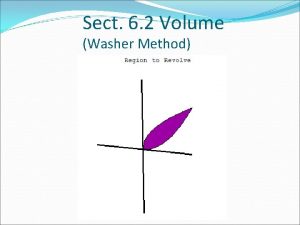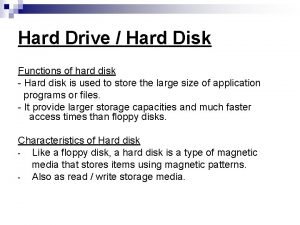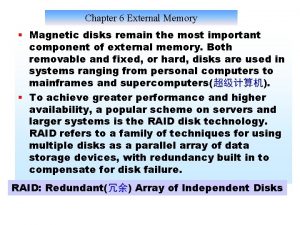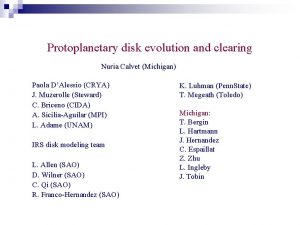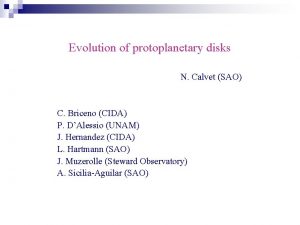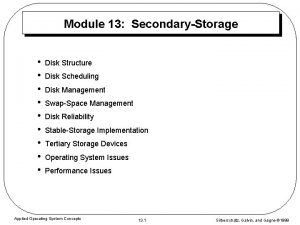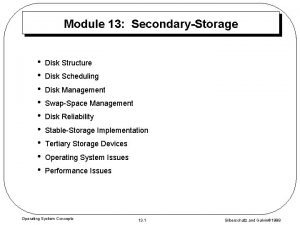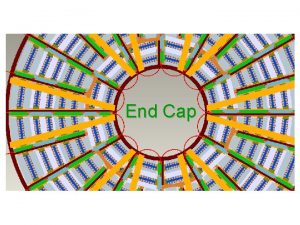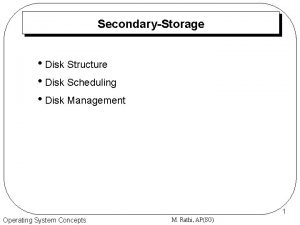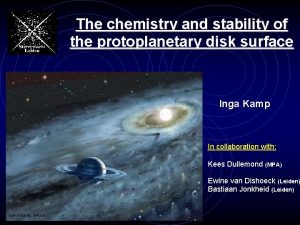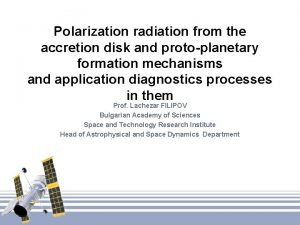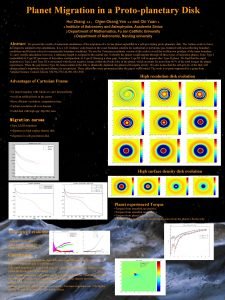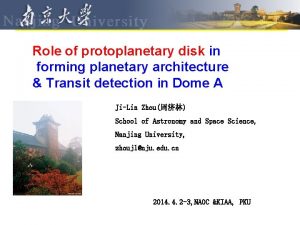Protoplanetary disk evolution and clearing Nuria Calvet Michigan

















































- Slides: 49

Protoplanetary disk evolution and clearing Nuria Calvet (Michigan) Paola D’Alessio (CRYA) J. Muzerolle (Steward) C. Briceno (CIDA) A. Sicilia-Aguilar (MPI) L. Adame (UNAM) IRS disk modeling team L. Allen (SAO) D. Wilner (SAO) C. Qi (SAO) R. Franco-Hernandez (SAO) K. Luhman (Penn. State) T. Megeath (Toledo) Michigan: T. Bergin L. Hartmann J. Hernandez C. Espaillat Z. Zhu L. Ingleby J. Tobin

Disk evolution and Clearing Disks evolve from optically thick dust+gas configurations to mostly solids debris disks HK Tau, Stapelfeldt et al. 1998

Optically thick disks (T Tauri phase) Photosphere Furlan et al 2006 • optically thick dust+gas configurations, formed in the collapse of rotating molecular cores • dust/gas ~ 0. 01 • heated by stellar radiation captured by dust (and viscous dissipation) • dust reprocesses heat and emits at IR • collisions transfer heat to gas, determines scale height • accreting mass onto the star

Optically thin disks (debris disk) Chen et al 2006 • dust/gas ~ 0. 99 • small secondary dust, from collisions of large bodies • large inner holes, tens of AUs • no gas accretion

Questions • How does gas evolve – dissipate? • How does dust evolve – formation of large bodies? • Characteristic times scales

Disks are accreting Excess energy over photospheric flux which cannot be accounted for by stellar energy Potential energy of matter accreting onto star Accretion from disk (where most of the mass of the molecular cloud core was deposited)

Disks are accreting Inner disk is truncated by stellar magnetic field (~ KG, Valenti & Johns-Krull papers) at ~ 3 -5 R*. Matter flows onto star following field lines – magnetospheric accretion flow Hartmann 1998

Evidence for magnetospheric accretion Excess emission/veiling Broad emission lines Muzerolle et al. 1998, 2001 v ~ 250 km/s v ~ 0 km/s velocity

Evidence for magnetospheric accretion Excess emission/veiling Calvet & Gullbring 1998 Broad emission lines Muzerolle et al. 1998, 2001 v ~ 250 km/s v ~ 0 km/s Redshifted absorption if right inclination

Accretion luminosity and mass accretion rate Excess emission over photosphere ~ Lacc = G M (d. M/dt) / R Gullbring et al. (1998) Ingleby et al 2007 STIS data Link to disk properties

Present picture of inner disk Near-IR emission mostly from wall at dust destruction radius

Emission from Wall at dust destruction radius • Emission ~ Black-body at T ~ 1400 K, ~ vertical wall frontally illuminated • Increases with accretion luminosity, T ~ 1400 K at larger radius • Rd (L* + Lacc ) 1/2 Consistent with Lacc determinations Muzerolle et al 2003

Accretion luminosity and mass accretion rate • Measure d. M/dt for populations ~ 1 - 10 Myr • UV excess or excess at U (calibrated to Lacc) • Intrinsic chromospheric emission prevents measurement of low accretion luminosity • Model Ha line profiles to get mass accretion rate (Muzerolle papers) • Basis of all calibrations to obtain mass accretion rates for weak accretors (ie, brown dwarfs, “weak” TTS) • Uncertainties: temperature structure, geometry, effects of winds (Alencar et al. 2006; Kurosawa et al 2006)

Mass accretion rate decreases with time Viscous evolution - Gas Hartmann et al. (1998), Muzerolle et al. (2001), Calvet et al. (2005)

Viscous evolution S(R) decreases with time Disk expands Region of d. M/dt ~ const, S ~ 1/R Models for steady disks Irradiated accretion disks (D’Alessio models) using d. M/dt onto star (from UV) Hartmann et al. (1998) S(R) given d. M/dt determined from UV for each object (not a free parameter)

Irradiated steady accretion disks • Irradiated (steady) accretion disks (D’Alessio models) S(R) given observed d. M/dt S ~ (d. M/dt) / a • Uncertainty in a • Mdisk ~ S x size, a “calibrated” by measurement of disk mass • Uncertainty in mass determination – dust opacity, multiwavelength observations to constrain dust mixture • If MRI, then layered accretion (Gammie 1996), dead zone • Photoevaporation (Clarke et al 2001)

High accretors: FU Ori Inner disk: standard accretion disk d. M/dt ~ 10 -4 Msun/yr Instability region ~ 0. 6 AU, >> Bell & Lin 1994 Flared outer disk irradiated by inner disk Zhu et al 2007

High accretors: DR Tau Silicate emission and high far-IR flux because of irradiation by high energy radiation from accretion shock viscous wall d. M/dt = 2 e-7 Msol/yr D’Alessio et al 2007

High accretors at 5 Myr Orion OB 1 b sample (Hernandez e al 2007)

Mass accretion rate decreases with time . 50. 23. 12 Hartmann et al. (1998), Muzerolle et al. (2001), Calvet et al. (2005) Fraction of accreting objects decreases with time: not explained by viscous evolution: dust evolution?

Dust properties from SED: Grain growth Median SED of Taurus amax = 1 mm amax=0. 3 mm, ISM D’Alessio et al 2001 amax increases, k 1 m decreases, less heating, less IR emission kmm increases, higher fluxes

Evolution of grains in disks • As disk ages, dust growths and settles toward midplane t=0 Upper layers get depleted Population of big grains at midplane Weidenschilling 1997 Dullemond and Dominik 2004

Settling of solids: TW Hya 3. 5 cm flux ~ constant => Dust emission Jet/wind? Nonthermal emission? Wilner et al. 2005

Wilner et al. 2005 Settling: bimodal grain size distribution Small + 57 mm Weidenschilling 1997 S ~ 1/R

Dust evolution effects on SED Decrease of dust/gas in upper layers Lower opacity, less heating, less IR emission, but silicate emission Increasing depletion of upper layers Weidenschilling 1997 D’Alessio et al. 2006 Dullemond & Dominik 2004; Lada et al 2006

Spitzer/IRS data of Taurus (1 -2 Myr) Large range of properties at one age Furlan et al. 2006

Settling of dust toward midplane Median of Taurus from IRAC fluxes for 60 stars (Hartmann et al 2005) and IRS spectra of ~75 objects (Furlan et al 2005) Furlan et al 2006 Depletion of upper layers: upp/ st Upper laters depleted by 10 to 1% of standard dust-to-gas ratio D’Alessio et al 2006

Settling of dust toward midplane: small grains in upper layers • Silicate emission feature formed in hot upper inner disk layers • Small grains in upper layers, consistent with settling • Crystalline components Sargent et al 2006

IRAC data for a number of clusters and associations with ages 1 – 10 Myr: Gradual decrease of excess emission [3. 6] – [4. 5] SED evolution: comparison at different ages Data from Hartmann et al 2005 Sicilia-Aguilar et al 2005 Lada et al 2006 Hernandez et al 2007 b Hernandez et al 2007 Taurus

SED evolution: inner disk Decrease of median slope with age: consistent with decrease of d. M/dt and dust settling in inner disk Photosphere Hernandez et al 2007 b

SED evolution Slope becomes stepper - less excess as Degree of settling increases wall Art by Luis Belerique & Rui Azevedo Accretion rate decreases disk log d. M/dt= -10, -9, -8, -7 S decreases

SED evolution Evolution of the median SED from IRAC and MIPS 24 measurements: Faster evolution of inner disk Sicilia-Aguilar et al 2005 Taurus 1 -2 Myr Tr 37 3 Myr NGC 7160 10 Myr

SED evolution Present evidence: As a given population ages, the fraction of remaining disks tend to have lower accretion rates and their dust more settled toward the midplane But fraction of remaining disks decreases with time. What happened to the other disks?

Transition disks? • Lack of significant excess flux below 10 mm • But flux comparable to the median of Taurus at longer wavelengths Model: • Clearing of the innermost, hotter disk regions • Truncated outer optically thick disk • Wall at truncation radius illuminated frontally by star

Transition disks TW Hya 10 Myr old Taurus median • Near to mid-IR flux deficit • Sharp rise • Flux at longer l consistent with optically thick emission Calvet et al 2002

Inner disk clearing Spectra from IRS on board SPITZER TW Hya, ~ 4 AU ~ 10 Myr Wall Optically thick outer disk Optically thin region with lunar mass amount of micron size dust + gas (accreting star) Inner disk Uchida et al. 2004

Inner disk clearing Co. Ku Tau 4, ~ 10 AU ~ 2 Myr T=15085 K 4 AU td No inner disk, silicate from wall atmosphere Non-accreting star Forrest et al. 2004; D’Alessio et al. 2005

More disks in transition in Taurus Rw ~ 24 AU outer disk + inner disk with little dust + gap (~ 5 -24 AU) Inner disk Rw ~ 3 AU only external disk but accreting star Calvet et al 2005

Transition Disk in a Brown Dwarf Rw = 1 AU Muzerolle et al 2006

Evolving transition disks: grain growth Micron-size grains in optically thin inner disk and wall ISM Rw = 47 AU Espaillat et al 2007 Ne II line, enhanced penetration of X-rays

Inner disk Substantial mass accretion rates and high mm fluxes in GM Aur, DM Tau, TW Hya CO emission in inner disk of TW Hya (Rettig et al 2004) H 2 emission from inner disk of GM Aur, DM Tau, TW Hya in FUV spectra (Bergin et al 2004) Ne II, X-ray induced ionization (Espaillat et al 2007, following ionization model Glassgold et el 2007)

Inner disk clearing: photoevaporation of outer disk? Evolution with photoeva poration Rg Evolution without photoeva poration Clarke et al 2001 UV radiation photoevaporates outer disk When mass accretion rate (decreasing by viscous evolution) ~ mass loss rate, no mass reaches inner disk Rg ~ G M* / cs 2(10000 K) ~ 10 AU (M*/Msol)

Inner disk clearing: photoevaporation of outer disk? Prediction: low mass accretion rate and mm flux in transitional disks Clarke et al 2001 But average mass accretion rates and high mm fluxes in GM Aur , DM Tau, TW Hya

Inner disk clearing: photoevaporation of outer disk? • Increasing hole sizes with mass • High disk masses and accretion rates • Transition disks in brown dwarfs (Muzerolle et al 2006) No significant UV flux • Inner disk

Inner disk clearing: planet(s)? Giant planet forms in disk opening a gap Wall of optically thick disk = outer edge of gap at a few AU Bryden et al 1999 Inner gas disk with minute amount of small dust – silicate feature but little near IR excess, bigger bodies may be present

Inner disk clearing: planets? • Tidal truncation by planet • Hydrodynamical simulations+Montecarlo transfer – SED consistent with hole created and maintained by planet – GM Aur: ~ 2 MJ at ~ 2. 5 AU – Rice et al. 2003 SED depends on mass of planet (and Reynolds number) 21 MJ 1. 7 MJ 0. 085 MJ 43 MJ

Inner disk clearing: planets? Co. Ku Tau 4, wall at ~ 10 AU No inner disk D’Alessio et al. 2005 Long term duration of system? Planet-disk system with planet mass of 0. 1 Mjup for Co. Ku Tau 4 Quillen et al. 2004

Inner disk clearing: planets? Planet formation can explain: • SEDs of transition disks • short timescale for transition phase ~ run-away gas accretion/gap opening • rapid disappearance of inner disk, viscous time scale at gap, increased efficiency of MRI in low opacity inner disk Problems: outer disk may make planet migrate inwards in viscous timescale, small a? Recurrent events? High accretors at advanced ages?

Summary • Space data crucial for progress in understanding disk evolution • Disks gradually evolve accreting mass at decreasing rates onto star while dust grows and settles toward midplane • At some point, disk enters into transition phase, eventually turning off accretion and clearing up inner disk • Alternative models for clearing are planet formation and photoevaporation of outer disks. Present evidence may favor planet formation • Need characterization of properties of transitional disks in large samples of different ages plus theoretical efforts
 Protoplanetary disk
Protoplanetary disk Joan calvet
Joan calvet Caroline calvet montpellier
Caroline calvet montpellier Calvet
Calvet Langue isolante exemple
Langue isolante exemple Types of storage management
Types of storage management Clearing and settlement
Clearing and settlement Direct custody
Direct custody Mcdr egypt
Mcdr egypt Tozilizumab
Tozilizumab Núria cirera
Núria cirera Dioses griegos y romanos
Dioses griegos y romanos Raquelfontine
Raquelfontine Nuria sanz unesco
Nuria sanz unesco How to set up trays and trolleys
How to set up trays and trolleys Fort bliss conus levy brief
Fort bliss conus levy brief Ranch brush clearing
Ranch brush clearing Clearing california skies
Clearing california skies Eg ach
Eg ach Degreeworks uci
Degreeworks uci Webreg uci
Webreg uci Biosafety clearing-house
Biosafety clearing-house Chris edmonds ice
Chris edmonds ice Oriental clearing agencies
Oriental clearing agencies Rtgs vs npsb
Rtgs vs npsb Room clearing procedures
Room clearing procedures Critical clearing angle
Critical clearing angle Critical clearing time
Critical clearing time Power world
Power world Doctorate in clinical psychology clearing house
Doctorate in clinical psychology clearing house Cmfclearinghouse
Cmfclearinghouse Gr/ir clearing
Gr/ir clearing Courbe des taux tunisie clearing
Courbe des taux tunisie clearing Upper division writing uci
Upper division writing uci National automated clearing house association rules
National automated clearing house association rules Mcti dorms
Mcti dorms Michigan department of licensing and regulatory affairs
Michigan department of licensing and regulatory affairs Miosha respiratory protection
Miosha respiratory protection Disk and washer method
Disk and washer method Define hard disk drive
Define hard disk drive Optical disk
Optical disk Why do disk stars bob up and down as they orbit the galaxy?
Why do disk stars bob up and down as they orbit the galaxy? Disk and washer method
Disk and washer method When the process issues and io request
When the process issues and io request Ichat michigan login
Ichat michigan login Michigan state police ichat
Michigan state police ichat Michigan business travel association
Michigan business travel association Usgs streamflow michigan
Usgs streamflow michigan Michigan state police teenage defensive driving
Michigan state police teenage defensive driving Erau student handbook
Erau student handbook






































